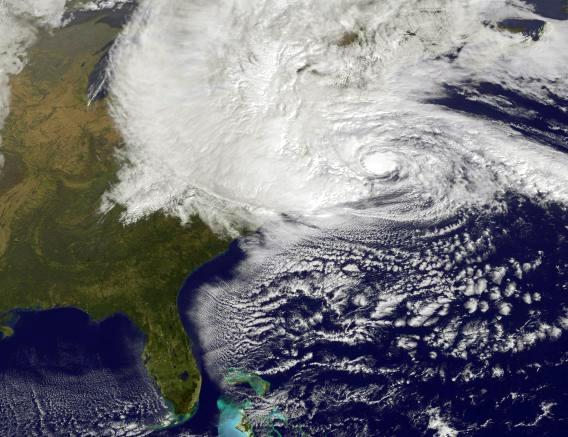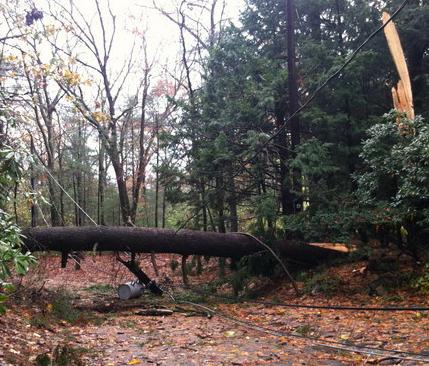  The picture above is a satellite image of hurricane Sandy approaching the East Coast of the United States on the morning of Monday, October 29, 2012. It was taken by a GOES satellite (Geostationary Operational Environmental Satellite). The storm wreaked havoc on the coast, particularly in New York City and New Jersey. The storm weakened rapidly after turning inland at the New Jersey coast, but it was a very broad storm, about 1,600 km wide (1,000 miles). Thus its effects were felt even here in the Boston area, about 450 km (280 miles) from the point where it made landfall just a bit south of Atlantic City. It brought us high winds and, as measured at my house, about 9 cm of rain (3.5 inches).
The trees were not removed until the second day after the storm, at which point our power was finally restored. Compared with the devastation in New York City and New Jersey, though, we couldn't feel too sorry for ourselves. Although we were inconvenienced, and lost a good deal of frozen food, the effects for us were not very serious. This was the first lengthy power failure I've endured since getting a smart phone (see my blog entry Upgrade). It was quite a pleasure to continue to have Internet access in the absence of electricity, and also to be able to send and receive e-mails. It was valuable to be able to read the various announcements being sent out by the town of Wayland and by our electrical supplier NStar. When communicating data over Verizon's 4G network, the phone tended to go through its battery rather quickly. However, it was easy to recharge it in my car. I simply put the key into the accessory position in order to turn on power to its 12 volt outlet, and then charge the phone using the phone's standard car charger. I spoke by phone to my sister Alice, who lives in Manhattan. She had a harder time than we did. We don't lose our water pressure in power failures, so we always have available water, and we can flush our toilets. In a Manhattan apartment building, which I suspect has a water tank on the roof, loss of electrical power means eventual loss of water. But following standard storm preparation guidelines, Alice had filled her bathtub with water. She could thus flush her toilet by pouring a large pot of water into it. Having also had the foresight to have matches available, she could cook on her gas stove. The burners are normally electrically ignited, but in the absence of power they can be lit by hand with a match. In that respect, she was better off than us - our stove is electric. Alice lives about a block away from Bellevue Hospital, one of the city's largest public hospitals. When the power first went out in southern Manhattan, large generators were switched on to provide power. However, two days later, flooding in the basement shorted out the fuel pumps feeding the generators. As I write this three days after the hurricane, with electrical power still out in lower Manhattan, all patients had to be evacuated from the hospital. From her apartment, Alice has been watching the parade of ambulances and National Guard personnel performing the evacuation. Since elevators can't be used, the patients had to be carried down stairwells on stretchers. Some of the patients needed to be carried down from as high as the 18th floor. I had the impression that hurricanes don't come up the East Coast has frequently as they used to. I seemed to remember very frequent hurricanes in the New York area when I was growing up, and fewer of them in recent years. To check out this perception, I took a look at a Wikipedia site that lists hurricanes that have hit the New York City area. Here's a simple chart I made using the data on that page. My chart shows the number of hurricanes and tropical storms that hit the New York area each year from 1954 through 2012. The storms are counted by the number of X's above the year. Thus the chart starts with three storms in 1954. 2004 had five storms, the highest number.
The chart seems to make it clear that my perception was inaccurate. If anything, there have been more storms in recent years. My faulty memory will have to yield to the record - as some scientist once said, "Before the data, we can but bow". Note 1 I recall my father bringing in a bushel of firewood in preparation for one of the storms of my youth, probably in the early 50s. The bushel basket had been sitting outdoors in a wooded area for quite some time. As we started removing some of the wood to stack it in the fireplace, we found a pair of mice in a nest among the pieces of wood. We somehow managed to catch them, and kept them in a cage we had on hand. They were white footed field mice, with the Latin name Peromyscus Maniculatus Gracilis, as my father noted (he had been a biology major at Cornell). After the storm, we kept the mice in the cage for a couple of years. I took a look in the cage one day, and noticed that the mice had constructed a soft pink nest out of some sort of cottony material. It was a much better nesting material than the usual shredded newspaper we had given them in the past. I couldn't figure out immediately where they had gotten it, until I realized that they had chewed a large hole in the window curtains near their cage. Apparently, the wind from an open window had blown the curtains onto the cage. The mice had taken advantage of this to pull portions of the curtain into the cage and chew them apart. The curtains had a red pattern on white fabric, and the red and white threads all mixed up in the pile comprising their new nest made it look pink. The curtains were actually very nice curtains that had been made by Noémi Raymond. She was the wife of Antonin Raymond, the architect who had designed our house. We were sad to have her nice curtains damaged in this way. The mice were apparently happy enough in their new environment to actually breed successfully, producing a substantial litter of babies which they raised in the cage. As the babies started to grow, we decided that this would be a good time to release the new family back into the wild. Hurricanes have always been something we've had to contend with here in the Northeast. In my youth, they were always given women's names. Now, we alternate men's and women's names, in alphabetical order A through Z. But this year's Sandy was particularly devastating. By making landfall in southern New Jersey, it brought powerful winds from the northeast to drive water into New York Harbor from the South and into the Long Island Sound, and hence into New York City from the North as well. It brought an enormous storm surge to the most densely populated coastline in the United States on the day of a full moon (and hence astronomical high tides). Note 2 As I write this three days after the storm, the death toll from Sandy has reached 88, according to a story in the L.A. Times. The storm produced historic damage, many billions of dollars. We up here in Massachusetts had it relatively easy. Would this be one of my blog entries without a linguistic note? As I was sitting around with time on my hands (it's really hard to get things done in the dark), I started thinking about the odd word "hurricane". English has imported words from many languages, but I knew that the same word in French, Spanish, and Italian were all cognates: ouragan, huracán, and uragano respectively (the Latin languages often drop an H in the spelling, because in those languages it's silent). Where did it come from? My Barnhart Concise Dictionary of Etymology says: Note 3
Some web searches will bring up theories as to how this Arawak word got adopted in Spanish, and how from there it was carried into English and into the major Romance languages (I just looked it up in Romanian, and it's uracan).
  Note 1: When I first saw this wonderful quote, I neglected to note the name of the author. I know it was a biologist, reasonably well known, but I can't remember who. And all efforts I've made to find a citation on the internet have proved futile. Anyone? [return to text] Note 2: Weather forecasters in New England often refer to "astronomical high tides" on television. But I fear that many listeners misinterpret this, since the word "astronomical" is sometimes used casually simply to mean "extremely large". But in this context, "astronomical high tides" refers to high tides that are higher than usual because of the alignment of the sun and the moon with respect to the earth. Tides are highest when the effect of the sun's gravity adds to that of the moon's, which occurs when the sun, the earth, and the moon lie in a straight line. This happens about twice a month, when there is either a full moon, or a "new moon" (no visible moon at all). [return to text] Note 3:
The Barnhart Concise Dictionary of Etymology, Robert K. Barnhart, 1995, HarperCollins Publishers, New York, NY, ISBN 0-06-270084-7. [return to text]
 |
